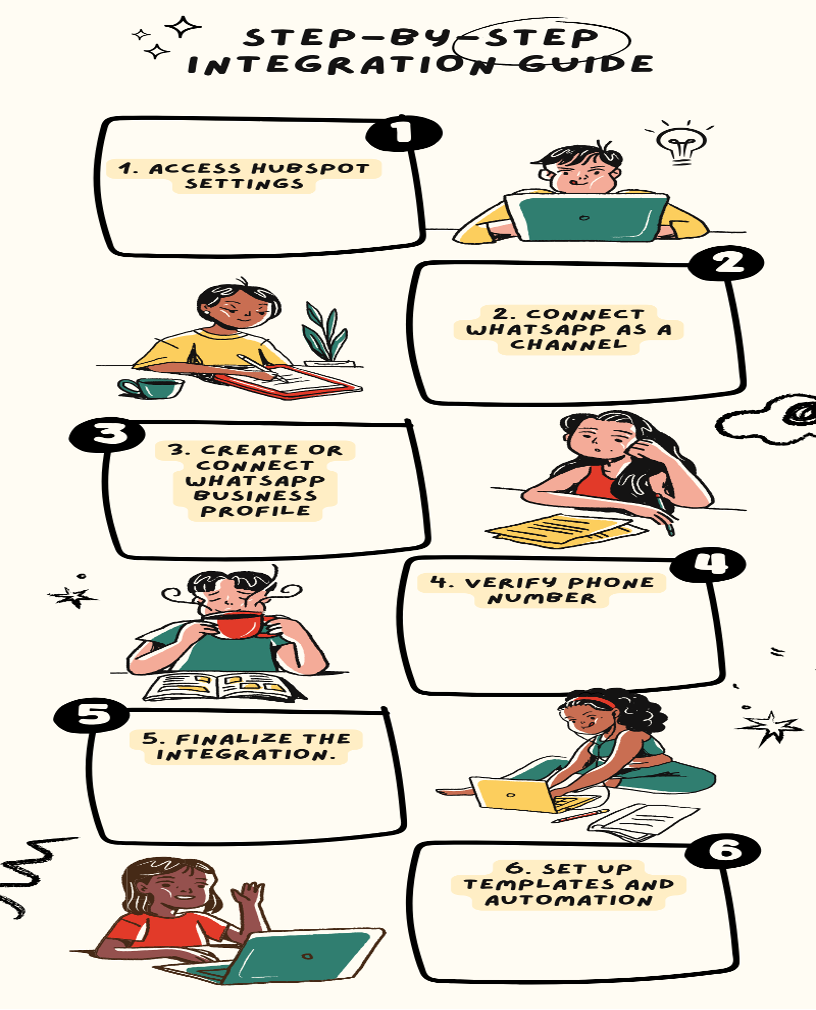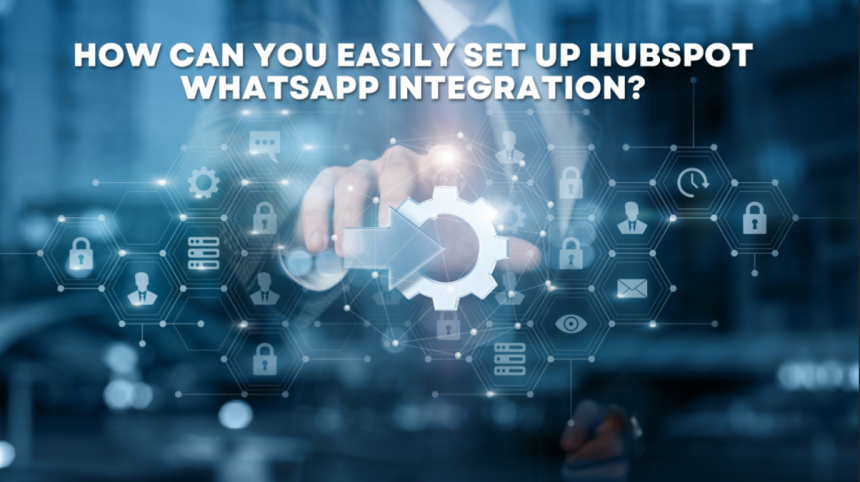Today, businesses aim to boost communication and engagement. A popular solution is integrating WhatsApp with HubSpot. This blend uses WhatsApp’s messaging and HubSpot’s CRM power.
Establishing this integration simplifies communication channels. With it, you can streamline tasks, manage chats in HubSpot, and automate messages. It offers a complete view of customer interactions, ensuring timely engagement. It covers everything from basics to advanced tips. It is for both experienced communicators and beginners. It makes it simple to enhance your strategy.
Among the connected applications, connecting WhatsApp to HubSpot will be the one that enhances your clients’ communication process, merging marketing, sales, and service flows. Thus, using the hubspot whatsapp integration, it is possible to sort the correspondence, track messages in the application, and send relevant messages.
The integration of these two processes provides an overview of overall customer interactions and ensures that conversations are pertinent across all channels.
This is indeed a one-stop guide on the ways, manners, and methods of using social media for planning and executing customer interactions whether you are a novice or an expert on these tools, this guide provides practical procedures from the preliminary stage to some of the most complex processes that will assist you in achieving the optimum benefit of employing the customer communication.
Why Integrate WhatsApp with HubSpot?
Before we start the setup, let’s understand why this hubspot whatsapp integration, is so valuable:
- Wider Audience: WhatsApp has over 2 billion users. This offers a huge market for your business.
- Centralized communication generates rapid answers, allowing teams to tackle queries quickly.
- Tailored Interaction: Using HubSpot’s CRM data, you can create personalized messages. This boosts satisfaction and loyalty.
- Automated Processes: Linking these platforms cut down on manual work. This saves time and lowers mistakes.
Now, it is very important to describe the integration process in more detail, stage by stage.
Conditions to conduct integration of HubSpot and WhatsApp
Before beginning, make sure you have the following:
1. A WhatsApp Business account
2. Admin access to your Meta Business Account
3. A dedicated phone number for WhatsApp Business.
4. A HubSpot subscription (Marketing Professional, Enterprise, or Service Professional/Enterprise)
These prerequisites are crucial for a smooth integration process. Without them, you may encounter roadblocks that prevent a successful setup.
Step-by-Step Integration Guide

1. Access HubSpot Settings
First, log into your HubSpot account and navigate to the settings menu
2. Connect WhatsApp as a Channel
In the settings menu, look for the ‘Channels’ or ‘Integrations’ section. Here, you should find an option to add WhatsApp as a communication channel.
3. Create or Connect WhatsApp Business Profile
Before proceeding, make sure you register the WhatsApp Business profile if you have not done so already. Here, you can connect it if you have already set it up.
4. Verify Phone Number
WhatsApp will send a code to verify your Business account. They will send it to the phone number linked to your account. Enter this code to verify your number.
5. Finalize the Integration.
Once you verify it, you can connect WhatsApp to your HubSpot account. You should now see WhatsApp conversations appearing in your HubSpot inbox.
6. Customize Your Inbox
Take some time to set up custom views in your HubSpot inbox. This simplifies the tracking of specific interaction types.
7. Set Up Templates and Automation
Use HubSpot’s features to make message templates. Set them to send automatic responses for common questions.
Leveraging the Integration
Now that you’ve set up the integration and start to make the most of it:
1. Centralized Communication Hub
Use HubSpot as your central point for all customer communications. This allows for better tracking and management of customer interactions across all channels.
2. Enhanced Customer Engagement
Leverage HubSpot’s CRM data to personalize your WhatsApp messages. This could include using the customer’s name. You could also mention their past purchases. Or, you could acknowledge their history with your company.
3. Rich Media and Interactive Messaging
Make good use of images, videos, and documents sharing on WhatsApp. This enhances the experience of the consumers and provides a backbone to the marketing strategies.
Troubleshooting Common Issues
Even with careful setup, you might encounter some issues. Here are some common problems and their solutions:
1. Server Connectivity Problems
You should first verify your internet connection if you have an issue and face an interruption in the connection. If the case is like this, it may be a HubSpot or WhatsApp web or application server problem. To confirm their availability look at their status pages and see if they’ve posted any outages.
2. Integration Limits
Note that WhatsApp restricts the number of communications up to 1,000 per month. If you go beyond this, you will have to change your plan or strategize your messages in order not to exceed the allowed amount.
3. Technical Support
If you’re lost, always remember that you can always run to HubSpot support for help. They offer comprehensive resources and can assist with most integration issues.
Advanced Tips for Power Users
Once you’re comfortable with the basic integration, consider these advanced strategies:
1. Integrate with Other Tools
Connect your HubSpot-WhatsApp integration with other tools. These tools include Slack or Zoom. They enable even more streamlined communication.
2. Automate Campaigns
Use HubSpot’s automation to create targeted WhatsApp campaigns. Base them on customer behavior or demographics.
3. Monitor Performance
Track WhatsApp communication performance using HubSpot’s analytics monitoring. Refine your strategy with these insights.
Comparison Table: HubSpot WhatsApp Integration vs. Traditional Communication Methods
| Feature | HubSpot WhatsApp Integration | Traditional Email | Phone Support |
| Real-time Communication | Yes | No | Yes |
| Centralized Data Storage | Yes | Varies | No |
| Automation Capabilities | High | Medium | Low |
| Rich Media Support | Yes | Limited | No |
| Cost-effectiveness | High | Medium | Low |
| Customer Preference | High | Medium | Varies |
| Analytics and Tracking | Comprehensive | Limited | Limited |
This table lists the benefits of integrating WhatsApp with HubSpot. It compares this to traditional methods. The integration of all these media relays results in a more efficient, less time-consuming, and customers-oriented business communication media mix.
Frequently Asked Questions (FAQs)
1. Is it possible to integrate the personal WhatsApp number for a desired business with HubSpot?
No, you need a WhatsApp Business account for this integration. Personal accounts are not supported.
2. Will my existing WhatsApp messages appear in HubSpot after the integration?
No, only new messages sent and received after the integration will appear in your HubSpot inbox.
3. How many team members can use the integrated WhatsApp-HubSpot system?
This depends on your HubSpot subscription level. Check your plan details or contact HubSpot Support for specific information.
4. Can I send bulk messages through this integration?
When possible, it’s important to follow WhatsApp’s policies on bulk messaging. This will help you avoid account suspension.
5. Is the integration GDPR compliant?
The answer to your question is that both HubSpot and WhatsApp are companies that obey the General Data Protection Regulation, meaning they are GDPR compliant. But make sure that you only use the customer data as permitted by GDPR.
Conclusion
Incorporating WhatsApp with HubSpot may help improve your business communication plan. From this tutorial, it is possible to understand how the integration works and how to solve the arising problems, as well as enhance communications with customers and approach your tasks more efficiently.
However, one should bear in mind that these tips’ effectiveness does not solely depend on the configuration of integrated applications but also on the peculiarities of how these tools are employed. Track appropriately how you and your team are performing, seek feedback that will be provided by both the customers and other teams and learn more from the experience as time goes on.
Lynn Martelli is an editor at Readability. She received her MFA in Creative Writing from Antioch University and has worked as an editor for over 10 years. Lynn has edited a wide variety of books, including fiction, non-fiction, memoirs, and more. In her free time, Lynn enjoys reading, writing, and spending time with her family and friends.














